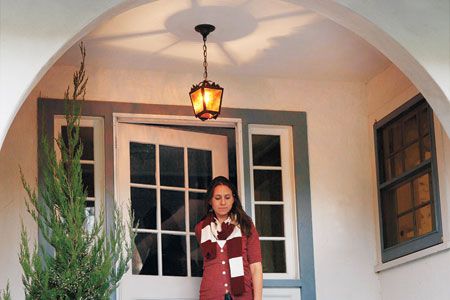We may be compensated if you purchase through links on our website. Our team is committed to delivering honest, objective, and independent reviews on home products and services.
 Wire stripper
Wire stripper Phillips screwdriver
Phillips screwdriver Pliers (heavy-duty)
Pliers (heavy-duty)
Vintage entry lanterns add charm and character to any home’s entryway. These classic fixtures cast a warm, inviting glow that welcomes guests and enhances curb appeal. However, many older lanterns require rewiring to function safely and efficiently. This guide will walk you through the process I used to rewire a vintage entry lantern, from assessing its condition to installing the restored fixture.
About Vintage Entry Lanterns
When a friend asked for help finding a replacement for the modern flush-mount fixture that used to light the entry to her 1930s cottage, I set out in search of a vintage hanging lantern that would better complement her home’s architecture. I picked up a mid-century painted steel lantern with amber glass panels in need of TLC at newyorksalvage.net. I then called the pros at Grand Brass Lamp Parts, one of the few remaining manufacturers of reproduction antique lighting parts, to order the wires, exterior-grade socket assembly, chain, and decorative ceiling canopy I needed to get the old lantern looking good and glowing again.
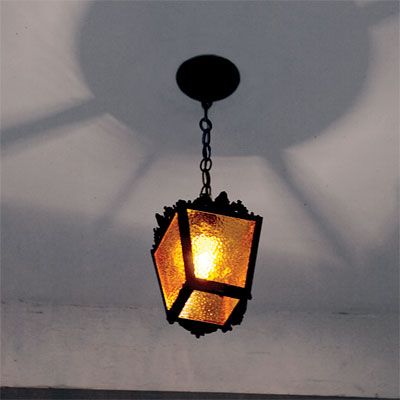
History of Vintage Lanterns
Many hanging lanterns from the first half of the 20th century were humble by design, looking as if they’d been crafted by blacksmiths rather than machines.
Dangling from unadorned chains, their iron, bronze, or copper cages often had hammer marks, grillwork, and even riveted seams reminiscent of those on medieval knights’ armor. And fitted with earth-toned frosted- or textured-glass panels, their warm glow complemented the coziness of the Craftsman bungalows, Tudor cottages, and more modest Colonial Revival homes in which they were most frequently hung. Popularized by tastemakers of the time, such as Gustav Stickley and the Roycroft crafters, these rustic lanterns exemplified a back-to-basics design sensibility. They were the antithesis of late-19th-century Victorian chandeliers cast from gleaming brass, with highly ornamented outstretched arms.
Common Types of Vintage Entry Lanterns
Vintage entry lanterns come in various styles and materials. Some common types include:
- Lanterns with clear, frosted, or colored glass panels
- Iron lanterns with a distressed or blackened finish
- Bronze lanterns with a patina that develops over time
- Copper lanterns that acquire a beautiful verdigris as they age
- Painted steel lanterns in various colors
Assessing Your Vintage Lantern’s Condition
Before beginning the rewiring process, evaluate the overall condition of your vintage lantern. This assessment will help you determine the extent of work needed and whether rewiring is necessary.
Identifying Necessary Repairs
Carefully inspect your lantern for any structural issues or damage. Look for:
- Rust or corrosion on metal parts
- Cracked or missing glass panels
- Loose or damaged decorative elements
- Bent or misshapen frames
Determining If Rewiring Is Needed
Examine the existing wiring for signs of wear, fraying, or brittleness. If the insulation is cracked or the wires feel stiff, it’s time to rewire. Additionally, if the lantern uses outdated wiring methods or materials, rewiring is essential for safety and compliance with modern electrical codes.
Gathering Tools and Materials To Rewire a Vintage Lantern
Before you begin your project, make sure you have all the materials you’ll need. The tools are fairly simple—you likely already have them in your toolbox.
Essential Rewiring Tools
- Wire stripper
- Needle-nose pliers
- Flathead and Phillips screwdrivers
- Electrical tape
- Multimeter (for testing connections)
Required Electrical Components
You’ll also need these electrical parts:
- UL-listed exterior-grade socket assembly
- Rubber-insulated lamp cord
- Decorative ceiling canopy
- Chain (if replacing)
- Hanging loop
- Ground wire
Disassembling the Lantern
Careful disassembly will preserve your lantern’s integrity and make the rewiring process smoother.
Removing Glass Panels
Gently remove any glass panels, taking note of how they’re secured. Some may be held in place by small metal tabs or screws. Place the glass in a safe location to prevent damage during the rewiring process.
Accessing the Wiring
Locate the access point for the wiring, which is typically at the top of the lantern. You may need to remove a decorative cap or unscrew a mounting plate to reach the internal wiring compartment.
Step-by-Step Rewiring Process
Follow these steps to rewire your vintage entry lantern safely and effectively.
Step 1: Remove the Old Wiring
Carefully disconnect and remove the old wiring from the lantern. Take note of how it was connected, as this can guide you when installing the new wiring.
Step 2: Install the New Socket
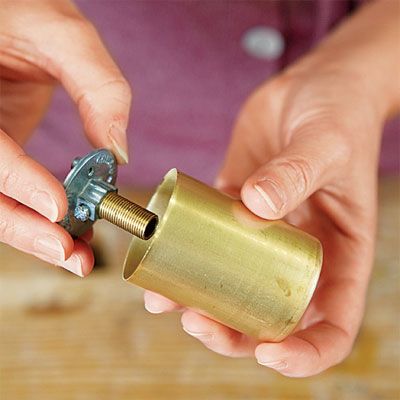
Begin by threading one end of a hollow brass screw (nipple) onto the metal cap that comes with your new porcelain socket. Tighten the cap’s set screw. Then, slip the brass socket housing over the other end of the screw.
Step 3: Secure the Housing and Ground Wire

Secure the housing and ground wire to the lantern by inserting the protruding end of the screw into the hole at the top of the fixture. Slip the ground wire’s ring over the screw and twist on a hanging loop.
Step 4: Split the Wires
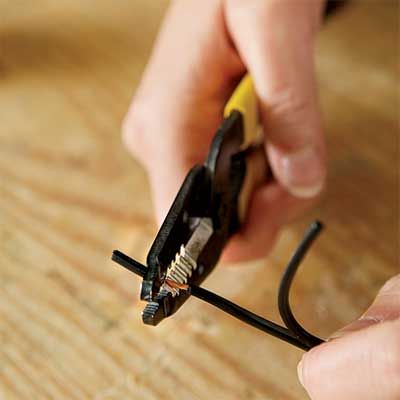
Rubber-insulated lamp cord comprises two wires joined at the center. Split them apart, and use a wire stripper to strip ½ inch of insulation from each, revealing bare copper.
Step 5: Connect the Wires

First, check the insulation. The neutral wire that wraps around the socket’s silver screw has ridges. The hot wire, which goes on the brass screw, is smooth. Wind the wires clockwise and tighten the screws.
Step 6: Fit the Socket in the Housing

Fit the socket in the housing, inserting the cord through the socket’s supplied insulation ring and through the screw and hanging loop. Secure the socket to its metal cap by tightening the small screws inside the socket.
Reassembling Your Vintage Lantern
With the new wiring in place, it’s time to put your lantern back together.
Step 1: Reattaching Glass Panels
Carefully reinstall the glass panels, ensuring they’re secure and properly aligned. Replace any damaged panels with period-appropriate replacements if necessary.
Step 2: Install a New Chain
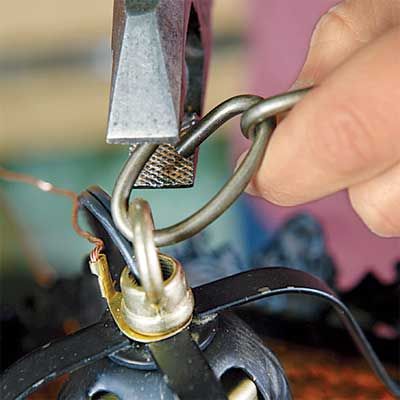
Attach one end of the chain to the hanging loop on the lantern and the other to the loop on the ceiling canopy. Use pliers to open and close the chain links as needed.
Step 3: Thread the Cord and Ground Wire
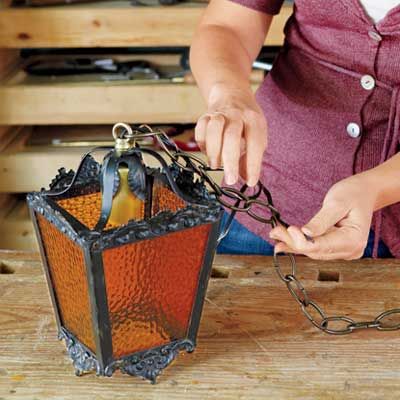
Thread the cord and ground wire through the chain and into the canopy’s hollow screw that connects to the fixture’s mounting hardware.
Safety Considerations When Rewiring a Vintage Lantern
Safety should be your top priority when working with electrical fixtures. Always turn off the power at the circuit breaker before beginning any electrical work. Use a voltage tester to confirm the absence of electricity in the wires. Wear insulated gloves and avoid working in damp conditions.
If you’re unsure about any aspect of the rewiring process or encounter unexpected complications, don’t hesitate to consult a licensed electrician. Complex wiring issues or concerns about your home’s electrical system are best addressed by professionals.
Enhancing Your Lantern’s Appearance
While rewiring improves functionality, you can also take steps to restore your lantern’s visual appeal.
Cleaning and Polishing Techniques
Use gentle cleaning methods appropriate for your lantern’s material. For metal surfaces, a mixture of mild soap and water often suffices. Avoid harsh chemicals that could damage the finish. Polish brass or copper elements with a suitable metal polish to restore their luster.
Restoring Painted Finishes
If your lantern has a painted finish that’s chipped or faded, consider repainting it. Use paint designed for metal surfaces and choose a color that complements your home’s exterior. Apply thin, even coats for the best results.
Installing Your Rewired Lantern
Now that your new lantern is ready to glow, you’ll need to decide where to hang it. Here are some steps to take when installing your rewired lantern.
Choosing the Perfect Location
Select a location that showcases your lantern’s beauty while providing adequate lighting. Consider the height and visibility from the street or walkway. Ensure the location is compatible with your home’s existing electrical wiring.
Mounting the Lantern Securely
Follow the manufacturer’s instructions for mounting the ceiling canopy and attaching the lantern. Use appropriate anchors and screws to ensure the fixture is securely fastened. Double-check all electrical connections before restoring power.
